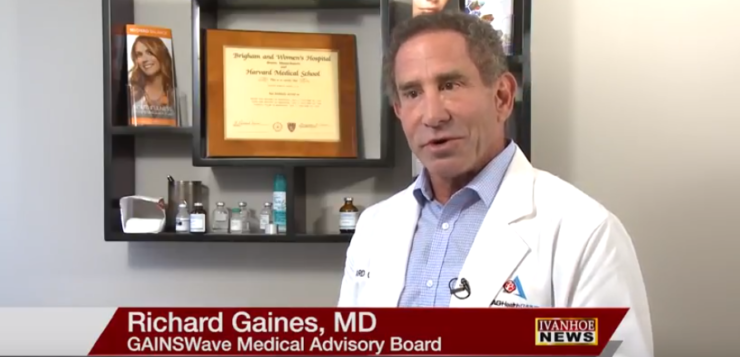Richard Gaines, MD, preventative medicine, specializing in age management medicine, GAINSWave Medical Advisory Board, talks about erectile dysfunction and a shockwave therapy treatment option.
Interview conducted in December 2017.
You specialize tell us a little bit about that?
My specialty is age management medicine. It’s actually a preventive form of medicine. Conventional medicine is more of a disease-oriented specialty and that’s how it has developed in this country. I practice age management, which is preventive and we prevent the need for many of the procedures and drugs that are out there now and just used as a Band-Aid. So it’s preventive, and it’s very rewarding.
Dr. Gaines let’s begin with something that affects so many people but no one wants to talk about it. Sexual dysfunction, erectile dysfunction (ED) how prevalent is it in this country?
Dr. Gaines: Incredibly prevalent and it’s undertreated. We know that since Viagra came out and Cialis and all these PDE5 inhibitors general medicine is involved with it but minimally so, these are just Band-Aids. These PDE5 inhibitors; when you take them, first of all they have side effects. But when you take them it’s actually forcing blood into your pelvic vessels and their diseased vessels. There older vessels they need to be opened up, these PDE5 inhibitors work that way. GAINSWave therapy actually treats the root cause of the problem and regenerates these blood vessels.
Now before we get to GAINSWave, how many people would you say are affected by what we call ED?
Dr. Gaines: Yes, the prevalence, it’s incredibly high. It’s not talked about, there’s a little taboo to it, much less so than twenty years ago but there’s still a sense of it being uncomfortable. Doctors are uncomfortable asking their patients about it. We know from the data that forty percent of forty years old have an issue, some form of erectile dysfunction, fifty percent of fifty year olds, sixty percent of sixty year olds, seventy percent of seventy year olds. That’s a lot of people.
That’s a lot of people and a lot of people don’t realize that young people obviously …
Dr. Gaines: It can happen, there are various reasons. The most common reason as we age is vasculogenic, it’s an arterial and venous problem that develops.
Can certain medications, side effects of medications cause this problem?
Dr. Gaines: Oh absolutely, there’s a whole list. There are probably a hundred medications that can influence your pelvic blood flow and your sexual response. Blood pressure pills across the board can do that; any type of psychiatric medicine can cause issues. You can just name it; these are considered iatrogenic causes caused by medical treatment. And honestly these pills, is it necessary, yes. But we know that it can affect the sexuality, and this begins with treatment that actually seems to help even those individuals who are on these medications.
You are the one who really kind of came upon this treatment, talk about what is GAINSWave therapy and how does it work? Is it noninvasive?
Dr. Gaines: You know it’s actually nothing I invented. Acoustic waves are waves that are not electronic, these are acoustic waves. Basically thunder is a shock wave, a shock wave that actually can break windows. It has nothing to do with electricity, even though it’s a phenomenon where there’s a big spark. But in general these shock waves are ubiquitous, they’re faster than the speed of sound and they have effect on human tissue. Now a lot of research was done in the early 40’s, 50’s, 60’s, and 70’s. And in the 1970’s they actually dissolved a kidney stone, in Germany. They developed the Dornier lithotripter and that type of technology is called extracorporeal shock wave therapy. From that point they started treating muscular skeletal conditions, increasing blood flow and all this was established in the medical literature before they tried it for ED. It makes a lot of sense to use it for ED if most ED is vasculogenic. So in 2010 they started using this in preliminary studies and a lot of European studies published over 40 studies now on this showing the benefits for erectile dysfunction.
How does it work? Using shock wave therapy you might get a little nervous, what is that, explain a little of that.
Dr. Gaines: I don’t like the term shock wave therapy, that’s why I came up with GAINSWave therapy. These acoustic waves, these sound waves transmit through the tissues; and various tissue types respond to this stimulation. If you think about it you know we live in an environment, we respond to our environment. Well cells in the body respond to the environment as well. If you shake them up a little bit they actually will secret growth factors and it actually attracts stem cells to the area where it’s being treated. Even stem cells that are localized in the area will proliferate. So it affects a lot of basic cellular function and over time we’ve seen this in a lot of animal studies. We know that the sound wave affects the tissue in a positive way if it’s used properly. Of course sound waves can be destructive like lithotripsy you want to destroy your stone. We are very careful in using only and recommending only devices that provide safe sound waves.
So talk a little about the procedure itself and is the sound wave therapy opening up vessels and is it creating more blood flow?
Dr. Gaines: Well it’s a combination of things. That’s a good question because we know that just applying this to the tissues will dilate blood vessels. So you do get an increase in blood flow. Now the machines in the United States are used for orthopedic reasons and muscular skeletal reasons. The machines I recommend are FDA approved for tennis elbow and plantar fasciitis; muscular tennis pain. It is also is approved for the temporary increase in blood flow, that’s what I’m using it for. Most medications in this country are used off label and we’re using this machine actually on label if you think about. It’s increasing blood flow; my temporary increase is actually probably for two years, that’s what the studies show. But what happens is when these sound waves hit the surface of a blood vessel the endothelial cells respond and they will start making new blood vessels and repairing the cells; a process called angiogenesis or neovascularization. It’s been proven in tissues in rat studies and also even nerve tissue will heal, grow, and regenerate. Connective tissue reorganizes in a positive way, so it rejuvenates the whole anatomy. It’s fabulous. And it can re-establish the erectogenic mechanism.
Would this be a permanent effect or we don’t know yet?
Dr. Gaines: That’s a good question too. I mean honestly we know that studies show that its effects and the positive responses will remain for one to two years. But if you think about it we are humans we actually continue to age. Right now I’m actually offering a maintenance program for my patients. Where they can come back once every year and get treated. Even after one treatment the evidence shows that there is a good angiogenesis and there’s ideal neovascularization.
So many of your patients have some benefit after even just one treatment?
Dr. Gaines: We have early responders and late responders. I’m not sure of the reasons, some people think that the early responders if they get stimulated the vessels open up and they maintain their patency and they get immediate response that evening. We have people who say they have response that evening. We have late responders who after two or three months when the angiogenesis has taken effect they start getting benefits and the benefits continue. So it’s really exciting stuff. The other thing is, I mean we’re just talking about vascular reasons, but I think there are neurogenic reasons as well. And it could be some negative wiring that’s been set up over the years you apply this and it might sort of reset the wiring and that’s one of my reasons for early responders. You reset the wiring and things start working that evening. So we don’t know but there has to be more research.
Are you recommending a certain number of sessions or a number of treatments?
Dr. Gaines: There were forty studies that were done; many double blinded randomized control studies, a high level of medical evidence. I’ve taken their protocols and I’ve tweaked it to my patients. Two years ago I offered it free to my patients. I gave them one treatment free then subsequently started charging them in patient funded research. But we’ve tweaked the protocols to get the fastest and most long lasting results.
Is there any pain involved to the patient?
Dr. Gaines: It’s interesting the sensation is very different. I’ve heard it some patients say it’s sort of like a jack hammer which it really is because it’s just a sound wave going through the tissues. Or it’s a little stinging sensation. Some people say it’s like plucking hairs, but it’s variable, their responses are variable. We offer a topical anesthetic where we just put cream on, they become numb in the areas that we’re treating. And we can apply this and go up on the pressure as we go through the treatment. Just applying this alone creates a form of anesthesia. So applying it and going up gradually, they can tolerate the most effective level.
Any side effects that you’ve seen so far?
Dr. Gaines: I honestly with this type of therapy I have not seen any side effects. Of course maybe we’re looking for a little flushing of the skin to ensure that we’re increasing blood flow. But no excoriations, no bruising, no nothing. I am adverse to any side effects so I am very pleased with what I’ve done. We’ve done hundreds and hundreds of patients without any problems.
And you’re getting a lot of good feedback I would imagine.
Dr. Gaines: Incredibly good results.
Is this something that can be used on women?
Dr. Gaines: We are doing a small study, an in house study on females. There’s no reason why it shouldn’t work on females. Females also their first response to sexual stimulation is an increase in blood flow. That’s what we’re dealing with. And the twelve women we have in this study have demonstrated really good benefits. But we have to put it together, and I have providers throughout the country with whom I’m collecting, data. There are eighty providers; they’re located in all parts of the country. I’m looking at it here in Florida, but these are providers of mine I’ve trained them and we are comparing notes. It’s been very rewarding.
So if someone is seeking out this type of treatment should they talk to their neurologist and would they know about this?
Dr. Gaines: Well neurologists do know about this. I know because I’ve attended the American Neurological Association meeting where they had lectures on this type of therapy. And there was a lot of talk about it, so they know something about this therapy. Unfortunately they’re all waiting for specifically an FDA approved machine that’s specific for erectile dysfunction. They’re going to be waiting for a long time. I’m not sure, I’m not a conspiracist, but something is blocking this from happening in the United States. You can go to GAINSWave.com, you can find out everything you need to know about this. There’s a list of providers, and we’ll be glad to talk with you and give anybody information.
Like Michael he’s no longer needing the pills.
Dr. Gaines: No. He’s doing great, he’s one of my poster boys.
Can you talk about sessions, just give us a number and cost. How many sessions do you give, do people need and cost?
Dr. Gaines: We have different packages, but generally just for ED alone we recommend two treatments a week for three weeks, for a total of six treatments. Often if men have severe ED, we recommend some more treatments. There are a lot of other conditions and we tailor it to each individual patient. I can tell you a lot of patients who have been seeking me are people who have scar tissue in their penis; have a deviation. It’s incredible how many are out there. Ten percent of men, and that’s a big number, have experienced this or have maintained deviation. The neurologists know about this, they have the only FDA approved medication, this is can do damage. With this type of therapy it’s not invasive, and it actually can straighten and heal connective tissue. I have a handful of these patients who are very pleased now with what we’re able to offer. We have different packages for different conditions. We have a package for mild to moderate ED, moderate to severe ED, and very severe ED, or post prostatectomy. And we can tailor to each patient, but generally it is two sessions per week for three weeks. Then we also have a maintenance program; I’ve been encouraged by my patients to develop a maintenance program. So it seems to be working very well and I’m very pleased. Of course there is a cost to it that’s not covered by insurance. And the cost is between three thousand to five thousand dollars.
Depending on the package?
Dr. Gaines: Yes.
END OF INTERVIEW
This information is intended for additional research purposes only. It is not to be used as a prescription or advice from Ivanhoe Broadcast News, Inc. or any medical professional interviewed. Ivanhoe Broadcast News, Inc. assumes no responsibility for the depth or accuracy of physician statements. Procedures or medicines apply to different people and medical factors; always consult your physician on medical matters.
If you would like more information, please contact:
David Hernandez, MD
305-400-4718
Gary Grasso
Sign up for a free weekly e-mail on Medical Breakthroughs called First to Know by clicking here




